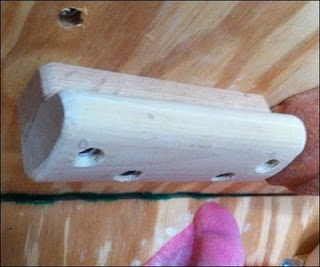
How can you get the most out of your home bouldering wall while keeping plenty of extra cash for other key climbing supplies, like chalk and beer?
Mass production of standard holds. Over the next several posts I am going to write up some strategies I have used to get more climbing potential out of our home bouldering wall. Later I might write up some posts about wall design and construction. For now, let’s focus on holds, and three principles to guide us:
1. The more the merrier. Ideally, every available space for a hold will be filled. You want to take full advantage of the space you have constructed.
2. Diversity is good. You want to have a wide array of hold types and sizes to maintain interest and stretch your imagination.
3. Consistent distribution. You want a variety of hold types in all parts of your space, so that hard, medium, and easy problems can cross all areas of the wall.
When do you have enough holds? When you can no longer fit any more holds on your wall. Our dojo is not there yet. Check out this shot.

The prime climbing area on the 30 degree wall is mostly filled with holds. We can squeeze a couple more around the edges, and we need some small footholds added throughout, but besides that, the area is pretty well filled. Notice the hold diversity. We have made an effort to spread small, medium and large holds; downward pulling edges, sidepulls, underclings and pinches; as well as vary how positive the holds are, though we have few true slopers because they take a lot of space and are hard to make at home. The distribution of types is pretty consistent, though at the edges we have placed more of the ‘likely to be used in that spot holds’.


In contrast, check out the relatively sparse distribution in the “kids” area, with the near vert walls and roof. Density could easily be doubled here. Also note that while the slabs hold some variation, the roof defaults to jugs, especially handle bars. The simple reason for this is access, we make the whole wall accessible to the widest range of abilities that we can. Clearly, we have room for improvement. We need more medium and small holds, more directionals, complex shapes, and footholds in this area.
Gym climbers may debate which hold manufacturer is best: SoIll, Etch, Pusher, Metolious, Straight Up (from long ago). But for the home climber, these companies are nice, but none of them can compare to Lowes or Home Depot when it comes to price.


























